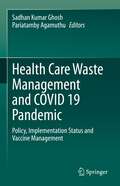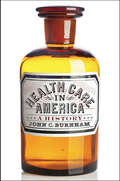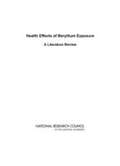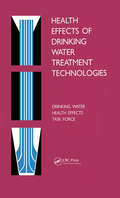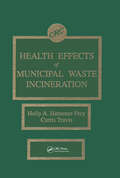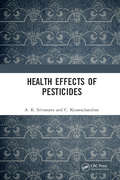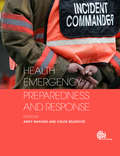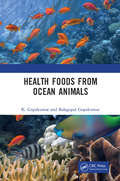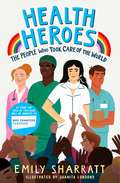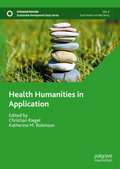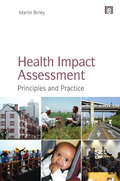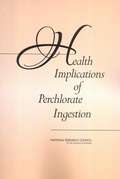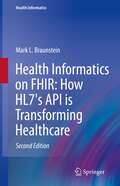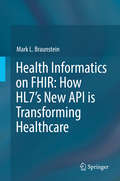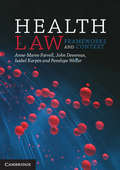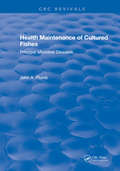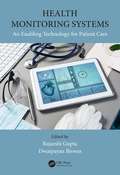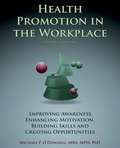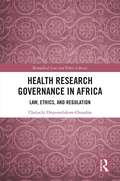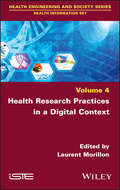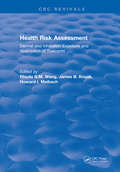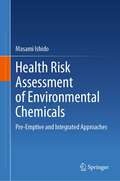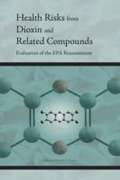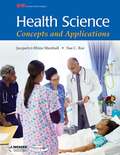- Table View
- List View
Health Care Waste Management and COVID 19 Pandemic: Policy, Implementation Status and Vaccine Management
by Pariatamby Agamuthu Sadhan Kumar GhoshThis book deals with the general principles, policy instruments, sustainability of supply chain, and business of health-care waste (HCW) management including inputs on exercise in immune health defense against COVID 19. Health-care waste management is very important in any country for protection of environmental and animal and human health. The COVID-19 pandemic, in addition, has augmented this importance to a greater extent. Italy has been successful in curbing the problems related to HCW management during the COVID-19 pandemic at very fast rates from the worst situation, while for a few countries in Asia and Africa, challenges still exist. It is necessary that policy makers, researchers, and implementers gain more knowledge and information on these aspects and improve the strategies and actions. Addressing these issues will reduce the cost of health care as well as resource inefficiency hindering sustainable development goals. This book is of interest and useful to practitioners, capacity builders and policy makers, entrepreneurs, NGOs, and general people, and is a valuable source of reference to the relevant researchers and students in global markets. The book serves as a reading material for undergraduate and graduate students of environmental science, waste management, and medical science. National and international scientists as well as policy makers will also find this to be a useful read.
Health Care in America: A History
by John C. BurnhamA comprehensive history of sickness, health, and medicine in America from Colonial times to the present.In Health Care in America, historian John C. Burnham describes changes over four centuries of medicine and public health in America. Beginning with seventeenth-century concerns over personal and neighborhood illnesses, Burnham concludes with the arrival of a new epoch in American medicine and health care at the turn of the twenty-first century.From the 1600s through the 1990s, Americans turned to a variety of healers, practices, and institutions in their efforts to prevent and survive epidemics of smallpox, yellow fever, cholera, influenza, polio, and AIDS. Health care workers in all periods attended births and deaths and cared for people who had injuries, disabilities, and chronic diseases.Drawing on primary sources, classic scholarship, and a vast body of recent literature in the history of medicine and public health, Burnham finds that traditional healing, care, and medicine dominated the United States until the late nineteenth century, when antiseptic/aseptic surgery and germ theory initiated an intellectual, social, and technical transformation. He divides the age of modern medicine into several eras: physiological medicine (1910s–1930s), antibiotics (1930s–1950s), technology (1950s–1960s), environmental medicine (1970s–1980s), and, beginning around 1990, genetic medicine. The cumulating developments in each era led to today's radically altered doctor-patient relationship and the insistent questions that swirl around the financial cost of health care.Burnham's sweeping narrative makes sense of medical practice, medical research, and human frailties and foibles, opening the door to a new understanding of our current concerns.
Health Effects of Beryllium Exposure: A Literature Review
by National Research Council of the National AcademiesThe National Academies Press (NAP)--publisher for the National Academies--publishes more than 200 books a year offering the most authoritative views, definitive information, and groundbreaking recommendations on a wide range of topics in science, engineering, and health. Our books are unique in that they are authored by the nation's leading experts in every scientific field.
Health Effects of Drinking Water Contaminants
by Edward J. CalabreseThis new book evaluates the risks and benefits of the widely used types of drinking water treatment technologies, based on assessment and comparison of chemicals used in treatment, by-products of chemicals, and non-treatment. This valuable material was prepared by independent experts in drinking water treatment technology and toxicology, in conjunction with EPA.
Health Effects of Municipal Waste Incineration
by Curtis C. Travis Holly A. Hattemer-FreyThis much-needed book provides an enlightening perspective on the environmental and human health impacts of municipal solid waste (MSW) incineration. Over 100 tables and figures allows speedy access to important data you will refer to again and again. The comprehensive text assesses the human health risks associated with exposure to facility emitted pollutants-especially the highly toxic dioxin. It includes an evaluation of multipathway (inhalation and food chain) exposures. This essential publication also evaluates facility emissions, plausible air concentrations, the potential for deposition of pollutants onto plant, soil, and water surfaces, the movement and accumulation of pollutants through environmental media, and the potential for human exposure. Health Effects of Municipal Waste Incineration is an up-to-date volume which encourages readers to formulate opinions about some of the fundamental issues affecting the management of municipal solid waste. Anyone involved with environmental science, hazardous waste, toxicology, risk analysis and/or environmental engineering will certainly value and utilize this well-written resource.
Health Effects of Pesticides
by A. K. Srivastava C. KesavachandranHealth Effects of Pesticides covers various aspects of the use of pesticides, their behaviour, degradation, and impacts on the agrarian environment. It focuses on pesticide poisoning incidents and farm practices in developing countries. The health impacts of pesticides, including neurological, respiratory, and dermal effects, are examined. Other repercussions caused as a result of pesticides, including reproductive abnormalities and cancer, are comprehensively discussed. Effects of pesticides on general health and agrarian health surveys have been touched upon. Please note: This volume is Co-published with The Energy and Resources Institute Press, New Delhi. Taylor & Francis does not sell or distribute the Hardback in India, Pakistan, Nepal, Bhutan, Bangladesh and Sri Lanka
Health Emergency Preparedness and Response
by Simon Lewis Gordon Macdonald Jonathan Van-Tam John John David David Roger Roger Peter Peter Glen Curry Philippa Philippa Anthony Rowe Verity Verity Professor Richard Williams Rob Rob Tim Tim Marianne MarianneIntensely practical and down to earth, this text covers the breadth of health emergency preparedness, resilience and response topics in the context of inter-disciplinary and whole society responses to a range of threats. It includes public, private and third sector roles in preparation for and in response to natural and man-made events, such as: major incident planning; infectious disease epidemics and pandemics; natural disasters; terrorist threats; and business and service continuity management. The book builds upon the basics of risk assessment and writing an emergency plan, and then covers inter-agency working, command and control, communication, personal impact and business continuity as well as training, exercises and post-incident follow up. Detailing the full emergency preparedness and civil protection planning cycle, the book is illustrated throughout with real-life examples and case studies from global experts in the field for countries with both advanced and developing healthcare systems. This practical handbook covering the essential aspects of major incident and disaster management is ideal for undergraduate and master's students in emergency management and public health, as well as for practitioners in emergency preparedness and civil protection. It will be valuable to all health practitioners from ambulance, hospital, primary and community care, mental health and public health backgrounds. Read the first chapter for free: Introduction: Why Do We Need to Prepare?
Health Foods from Ocean Animals
by K. Gopakumar Balagopal GopakumarMarine animals and their body constituents have been in use by mankind for nutrition and medical applications centuries ago. This book contains some well known and lesser known compounds from some important marine animals those have been consumed by man for centuries. This is the first book in this field and will serve as a reference for future researchers in the field. Note: T&F does not sell or distribute the Hardback in India, Pakistan, Nepal, Bhutan, Bangladesh and Sri Lanka.
Health Heroes: The People Who Took Care of the World
by Emily SharrattMeet the real-life health heroes!£1 from the sale of this book will be donated to NHS Charities Together. For readers aged 8+, Health Heroes is packed full of true stories of healthcare workers past and present, from all walks of life and from all around the world – from Florence Nightingale and Alexander Fleming to the midwives, doctors, paramedics and carers of today. From famous names to unsung heroes, these are real people being amazing – making new discoveries, putting themselves on the front line, and helping to take care of people in need, in all sorts of ways. Beautifully illustrated, and brimming with fun facts, information and inspiring true stories, this is the perfect read for future health heroes, fans of Goodnight Stories for Rebel Girls, Greta&’s Story and Stories for Boys Who Dare to Be Different – or anyone who just wants to join in the round of applause!
Health Humanities in Application (Sustainable Development Goals Series)
by Katherine M. Robinson Christian RiegelThis book focuses on health humanities in application. The field reflects many intellectual interests and practical applications, serving researchers, educators, students, health care practitioners, and community members wherever health and wellness and the humanities intersect. How we implement health humanities forms the core approach, and perspectives are global, including North America, Africa, Europe, and India. Emphasizing key developments in health humanities, the book’s chapters examine applications, including reproductive health policy and arts‑based research methods, black feminist approaches to health humanities pedagogy, artistic expressions of lived experience of the coronavirus, narratives of repair and re‑articulation and creativity, cultural competency in physician‑patient communication through dance, embodied dance practice as knowing and healing, interdisciplinarity and transdisciplinarity, eye tracking, ableism and disability, rethinking expertise in disability justice, disability and the Global South, coronavirus and Indian politics, visual storytelling in graphic medicine, and medical progress and racism in graphic fiction.
Health Impact Assessment: Principles and Practice
by Martin BirleyHealth Impact Assessment (HIA) is primarily concerned with the future consequences of plans, proposals and policies on the health of communities. It is a rapidly growing complement to Environmental Impact Assessment, increasingly mandated by national and international requirements. Guidelines have been produced by many national and international organizations and it is being introduced in a number of undergraduate or postgraduate university curricula. However, there has been until now no broad-based, introductory text of international scope to the subject, suitable for both these courses and for professional training. The purpose of this book is to fill this gap and to introduce the subject of Health Impact Assessment using plain language, in both general and specific contexts and with reference to both market and less developed economies. As a result, the reader should be able to describe what HIA can and cannot achieve, identify the components of a successful HIA and participate in an assessment as a member of a team. Examples are provided from a number of planning and development sectors, including extractive industry, water resource management, and housing. The reader, whether student or professional, need not be a health specialist, although prior knowledge of some public or environmental health would be an advantage.
Health Implications of Perchlorate Ingestion
by National Research Council of the National AcademiesPerchlorate—a powerful oxidant used in solid rocket fuels by the military and aerospace industry—has been detected in public drinking water supplies of over 11 million people at concentrations of at least 4 parts per billion (ppb). High doses of perchlorate can decrease thyroid hormone production by inhibiting the uptake of iodide by the thyroid. Thyroid hormones are critical for normal growth and development of the central nervous system of fetuses and infants. This report evaluates the potential health effects of perchlorate and the scientific underpinnings of the 2002 draft risk assessment issued by the U.S. Environmental Protection Agency (EPA). The report finds that the body can compensate for iodide deficiency, and that iodide uptake would likely have to be reduced by at least 75% for months or longer for adverse health effects, such as hypothryroidism, to occur. The report recommends using clinical studies of iodide uptake in humans as the basis for determining a reference dose rather than using studies of adverse health effects in rats that serve as EPA’s basis. The report suggests that daily ingestion of 0.0007 milligrams of perchlorate per kilograms of body weight—an amount more than 20 times the reference dose proposed by EPA—should not threaten the health of even the most sensitive populations.
Health Informatics on FHIR: How HL7's API is Transforming Healthcare (Health Informatics)
by Mark L. BraunsteinThis extensively revised textbook describes and defines the US healthcare delivery system, its many systemic challenges and the prior efforts to develop and deploy informatics tools to help overcome these problems. Now that electronic health record systems are widely deployed, the HL7 Fast Healthcare Interoperability standard is being rapidly accepted as the means to access and share the data stored in those systems and analytics is increasing being used to gain new knowledge from that aggregated clinical data, this book goes on to discuss health informatics from an historical perspective, its current state and likely future state. It then turns to some of the important and evolving areas of informatics including electronic healt\h records, clinical decision support,. population and public health, mHealth and analytics. Numerous use cases and case studies are employed in all of these discussions to help readers connect the technologies to real world challenges. Health Informatics on FHIR: How HL7's API is Transforming Healthcare is for introductory health informatics courses for health sciences students (e.g., doctors, nurses, PhDs), the current health informatics community, computer science and IT professionals interested in learning about the field and practicing healthcare providers. Though this textbook covers an important new technology, it is accessible to non-technical readers including healthcare providers, their patients or anyone interested in the use of healthcare data for improved care, public/population health or research.
Health Informatics on FHIR: How HL7's New API is Transforming Healthcare
by Mark L. BraunsteinThis textbook begins with an introduction to the US healthcare delivery system, its many systemic challenges and the prior efforts to develop and deploy informatics tools to help overcome those problems. It goes on to discuss health informatics from an historical perspective, its current state and its likely future state now that electronic health record systems are widely deployed, the HL7 Fast Healthcare Interoperability standard is being rapidly accepted as the means to access the data stored in those systems and analytics is increasing being used to gain new knowledge from that aggregated clinical data. It then turns to some of the important and evolving areas of informatics including population and public health, mHealth and big data and analytics. Use cases and case studies are used in all of these discussions to help readers connect the technologies to real world challenges. Effective use of informatics systems and tools by providers and their patients is key to improving the quality, safety and cost of healthcare. With health records now digital, no effective means has existed for sharing them with patients, among the multiple providers who may care for them and for important secondary uses such as public/population health and research. This problem is a topic of congressional discussion and is addressed by the 21st Century Cures Act of 2016 that mandates that electronic health record (EHR) systems offer a patient-facing API. HL7’s Fast Healthcare Interoperability Resources (FHIR) is that API and this is the first comprehensive treatment of the technology and the many ways it is already being used. FHIR is based on web technologies and is thus a far more facile, easy to implement approach that is rapidly gaining acceptance. It is also the basis for a ‘universal health app platform’ that literally has the potential to foster innovation around the data in patient records similar to the app ecosystems smartphones created around the data they store. FHIR app stores have already been opened by Epic and Cerner, the two largest enterprise EHR vendors. Provider facing apps are already being explored to improve EHR usability and support personalized medicine. Medicare and the Veteran’s Administration have announced FHIR app platforms for their patients. Apple’s new IOS 11.3 features the ability for consumers to aggregate their health records on their iPhone using FHIR. Health insurance companies are exploring applications of FHIR to improve service and communication with their providers and patients. SureScripts, the national e-Prescribing network, is using FHIR to help doctors know if their patients are complying with prescriptions. This textbook is for introductory health informatics courses for computer science and health sciences students (e.g. doctors, nurses, PhDs), the current health informatics community, IT professionals interested in learning about the field and practicing healthcare providers. Though this textbook covers an important new technology, it is accessible to non-technical readers including healthcare providers, their patients or anyone interested in the use of healthcare data for improved care, public/population health or research.
Health Law: Frameworks and Context (Oxford Studies In European Law)
by Isabel Karpin Farrell Anne-Maree John Devereux Penelope WellerHealth is a matter of fundamental importance in European societies, both as a human right in itself, and as a factor in a productive workforce and therefore a healthy economy. New health technologies promise improved quality of life for patients suffering from a range of diseases, and thepotential for the prevention of incidence of disease in the future. At the same time, new health technologies pose significant challenges for governments, particularly in relation to ensuring the technologies are safe, effective, and provide appropriate value for (public) money. To guard against the possible dangers arising from new health technologies, and to maximize the benefits, all European governments regulate their development, marketing, and public financing. In addition, several international institutions operating at European level, in particular the EuropeanUnion, the Council of Europe, and the European Patent Office, have become involved in the regulation of new health technologies. They have done so both through traditional 'command and control' legal measures, and through other regulatory mechanisms, including guidelines, soft law, 'steering'through redistribution of resources, and private or quasi-private regulation. This collection analyses European law and its relationships with new health technologies. It uses interdisciplinary insights, particularly from law but also drawing on regulation theory, and science and technology studies, to shed new light on some of the key defining features of the relationshipsand especially the roles of risk, rights, ethics, and markets. The collection explores the way in which European law's engagement with new health technologies is to be legitimized, and discusses the implications for biological or biomedical citizenship.
Health Maintenance of Cultured Fishes: Principal Microbial Diseases
by John A. PlumbThe text concentrates on the infectious viral and bacterial diseases that are most prevalent in aquaculture. Although much information has been derived from North American studies, important diseaase problems from other parts of the world are included. Also, where applicable, the influence of the various diseases on wild populations has been included. This book is intended for students and scientists who are interested in health maintenance of aquatic animals, aquatic pathobiology, and infectious diseases of fin fish. Hopefully, it will be used as a text for beginning fish pathologists and as a reference source for those of broader experience.
Health Monitoring Systems: An Enabling Technology for Patient Care
by Rajarshi Gupta Dwaipayan BiswasRemote health monitoring using wearable sensors is an important research area involving several key steps: physiological parameter sensing and data acquisition, data analysis, data security, data transmission to caregivers, and clinical intervention, all of which play a significant role to form a closed loop system. Subject-specific behavioral and clinical traits, coupled with individual physiological differences, necessitate a personalized healthcare delivery model for around-the-clock monitoring within the home environment. Cardiovascular disease monitoring is an illustrative application domain where research has been instrumental in enabling a personalized closed-loop monitoring system, which has been showcased in this book. Health Monitoring Systems: An Enabling Technology for Patient Care provides a holistic overview of state-of-the-art monitoring systems facilitated by Internet of Things (IoT) technology. The book lists out the details on biomedical signal acquisition, processing, and data security, the fundamental building blocks towards an ambulatory health monitoring infrastructure. The fundamentals have been complimented with other relevant topics including applications which provide an in-depth view on remote health monitoring systems. Key Features: Presents examples of state-of-the-art health monitoring systems using IoT infrastructure Covers the full spectrum of physiological sensing, data acquisition, processing, and data security Provides relevant example applications demonstrating the benefits of technological advancements aiding disease prognosis This book serves as a beginner’s guide for engineering students of electrical and computer science, practicing engineers, researchers, and scientists who are interested in having an overview of pervasive health monitoring systems using body-worn sensors operating outside the hospital environment. It could also be recommended as a reference for a graduate or master’s level course on biomedical instrumentation and signal processing.
Health Promotion in The Workplace (4th Edition)
by Michael O'DonnellHealth Promotion in the Workplace is a valued reference for anyone who designs, manages, evaluates or studies workplace health promotion programs. Authored by a team of program managers and scholars who have designed and managed programs in several thousand settings, conducted hundreds of program evaluations, and published thousands of scientific studies on the most effective approaches, this 722 page book provides the rare combination of practical perspective combined with conservative scientific rigor. This 4th edition is completely revised from the 3rd edition, which was published in 2002, and builds on the principles first articulated in 1984, in the 1st edition. The earlier editions have been used by tens of thousands of professionals around the world. The overall book is organized around the Awareness, Motivation, Skills and Opportunity (AMSO) Framework, which was first articulated by Dr. Michael P. O'Donnell in 2005. The AMSO Framework has been adopted by hundreds of employers, and integrated into federal legislation that guides federal spending in this area. This book is written with three audiences in mind. The largest audience is the rapidly growing network of professionals who have embraced health promotion as a career. Our hope for them is to provide the insights and tools they need to be as effective as possible in their work, and in turn improve the health and quality of life for millions of people every day. Another key group is human resource professionals who have not chosen health promotion as a career, but have been tasked with implementing programs in their own organizations. Our hope for them is to provide a tangible sense of how programs should work, so they know how to hire the best people to help them and how to monitor and oversee the successful rollout, evaluation, and evolution of a program. The most important audience may be students, most of whom are young people with open minds and passion, people who are still formulating career plans. Our hope is that this book opens their minds to a career path through which they can help individuals experience an enhanced health and sense of wellbeing, transform workplaces into communities that care for their workers while they improve productivity and moderate medical cost increases, all of which will help organizations remain financially sustainable and commercially successful. This text is appropriate for students in undergraduate and graduate level programs. The 23 chapters of the book are organized into six major sections. The three chapters devoted to The Health Promotion Concept, include the health perspective, the business case and the AMSO Framework. The four chapters in on Management cover how to design, manage, evaluate, and market a program. The five chapters on Core Theories describe the behavior change theories most important for health promotion: goal setting, Transtheoretical Model, incentives, self efficacy, and tailoring. The eight chapters on Building Skills address health assessment, fitness, nutrition, stress management, weight control, tobacco control, decision support and EAP. The two chapters on Enhancing Opportunities discuss the impact of social relationships on organization culture. The final chapter is on special challenges in small business settings, the untapped frontier for workplace health promotion.
Health Psychology in Action
by David Sheffield Mark ForshawA definitive guide to the growing field of health psychology, which showcases contributions from academics and professionals working at the cutting edge of their discipline.Explores the field of modern health psychology, its latest developments, and how it fits into the contexts of modern healthcare, industry and academiaOffers practical, real-world examples and applications for psychological theory in health care settingsProvides a timely resource to support the new HPC registration of health and other psychologistsIncludes contributions from practitioners in a wide range of health care settings who share their own vivid personal experiences, as well as more general guidance to applying theory in practice
Health Research Governance in Africa: Law, Ethics, and Regulation (Biomedical Law and Ethics Library)
by Cheluchi Onyemelukwe-OnuobiaThe globalisation of research has resulted in the increased location of research involving humans in developing countries. Countries in Africa, along with China and India, have seen research grow significantly. With emerging infectious diseases, such as Ebola and Zika, emphasising the risk of public health crises throughout the world, a further increase in health research, including clinical research in developing countries, which are often the sites of these diseases, becomes inevitable. This growth raises questions about domestic regulation and the governance of health research. This book presents a comprehensive and systemic view of the regulation of research involving humans in African countries. It employs case studies from four countries in which research activities continue to rise, and which have taken steps to regulate health research activity: South Africa, Nigeria, Kenya, and Egypt. The book examines the historical and political contexts of these governance efforts. It describes the research context, some of the research taking place, and the current challenges. It also looks at the governance mechanisms, ranging from domestic ethical guidelines to legal frameworks, the strengthening of existing regulatory agencies to the role of professional regulatory bodies. The book analyses the adequacy of current governance arrangements within African countries, and puts forward recommendations to improve the emerging governance systems for health research in African and other developing countries. It book will be a valuable resource for academics, researchers, practitioners and policy-makers working in the areas of health research, biomedical ethics, health law and regulation in developing countries.
Health Research Practices in a Digital Context
by Laurent MorillonThe current “generalized digitization” of society is influencing the health environment, healthcare organizations as well as actors. In this context, human and social sciences deconstruct, nuance and sometimes even challenge certain preconceived ideas and/or dominant discourses. In this book, researchers of four nationalities and three different disciplines have agreed to open the “black box” of their work. They display their scientific practices from the perspective of epistemology, ethics and methodology. They present and analyze their values and postulates but, also, what may have influenced the project, the definition of the object and objectives, as well as their approaches. In a contextual way, the first part presents some changes in environments and infocommunicational practices related to digital health. The second part opens space to reflect on ethics and deontology. Finally, postulating that scientific fact is not an essence but the result of a process, the last part discusses the methods implemented, which may be different from those initially envisaged. This book is dedicated to the researchers and postgraduate students in the human and social sciences as well as the health practitioners likely to collaborate with them.
Health Risk Assessment Dermal and Inhalation Exposure and Absorption of Toxicants (CRC Press Revivals)
by Howard I. Maibach Rhoda G.M. Wang James B. KnaakHealth Risk Assessment is a comprehensive reference focusing on dermal absorption, cholinesterase inhibition, adverse reproductive effects, and carcinogenicity. The book features contributions from over 40 top scientists and covers topics such as PBPK modeling, cytochrome P-450 metabolism in skin, percutaneous absorption, adverse effects, new skin models, and the role of epidemiology in assessing the hazards of toxicants. Health Risk Assessment is essential for toxicologists, environmental chemists, pharmacologists, risk assessors, and managers working in industrial, pesticide, and pharmaceutical development. The book will also benefit individuals in environmental, regulatory, and registration affairs, as well as academicians and students.
Health Risk Assessment of Environmental Chemicals: Pre-Emptive and Integrated Approaches
by Masami IshidoThis book presents the frontier research of toxicology and health risk assessment of chemicals. First, it provides an overview of the current methods of evaluating safety amounts of chemicals and provides a new aspect of the principle of toxicology. Secondly, it shows recent research where the new method of health risk evaluation is adopted, followed by an integrated health risk assessment of chemicals. Finally, it describes the epigenetic inheritance of chemical impact on health throughout several generations. Estimating the safety amount of chemicals surrounding our lives is not sufficient for health risk evaluation, particularly for carcinogenic compounds, endocrine disruptors, and nano materials. The author’s group has found a family of chemicals linked to ADHD through animal screening and identified its chemical nature using chemoinformatics methods. Based on these new developments, this book proposes to utilize the biomarker common to those chemicals for health risk assessment, independent of exposure routes and physiological dimensions. The book appeals to researchers and students in the field of toxicology, health risk assessment, pharmacology, and public health.
Health Risks from Dioxin and Related Compounds: Evaluation of the EPA Reassessment
by Committee on EPA's Exposure Human Health Reassessment of TCDD Related CompoundsAlthough the U.S. Environmental Protection Agency presented a comprehensive review of the scientific literature in its 2003 draft reassessment of the risks of dioxin, the agency did not sufficiently quantify the uncertainties and variabilities associated with the risks, nor did it adequately justify the assumptions used to estimate them, according to this new report from the National Academies&#39 National Research Council. The committee that wrote the report recommended that EPA re-estimate the risks using several different assumptions and better communicate the uncertainties in those estimates. The agency also should explain more clearly how it selects both the data upon which the reassessment is based and the methods used to analyze them.
Health Science: Concepts and Applications
by Jacquelyn Rhine Marshall Sue C. Roe Linda RomanoNIMAC-sourced textbook
